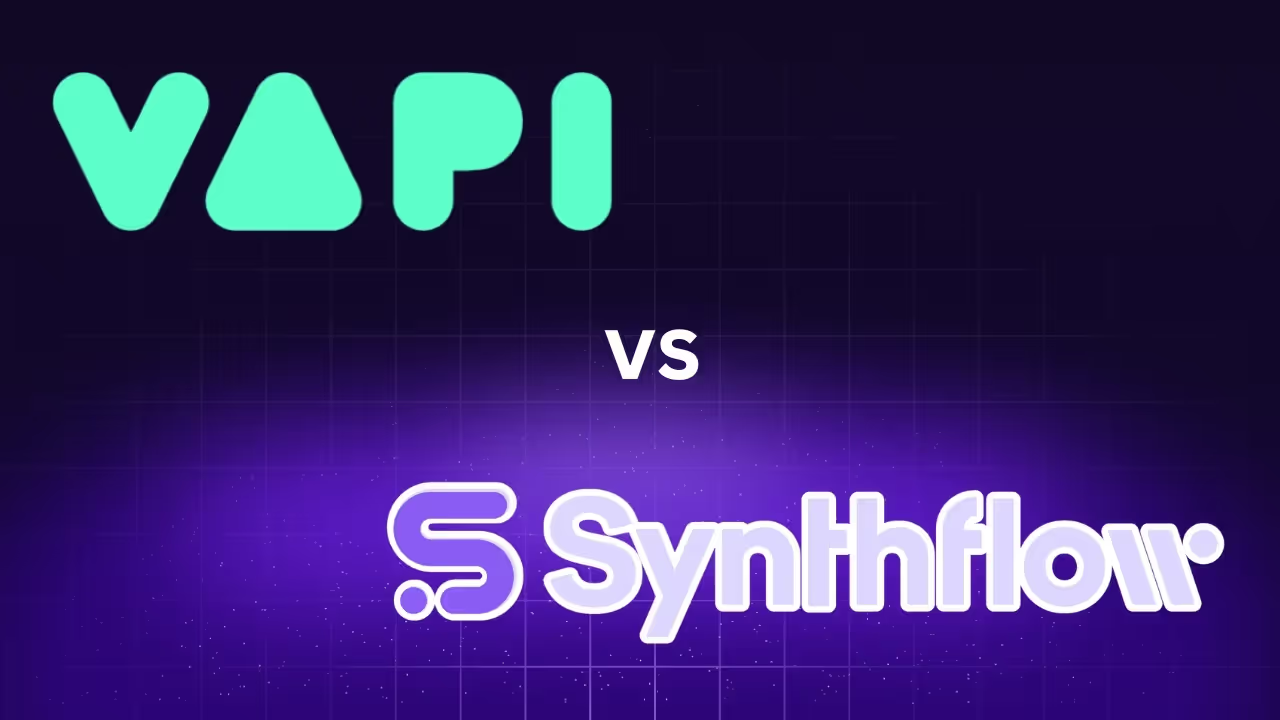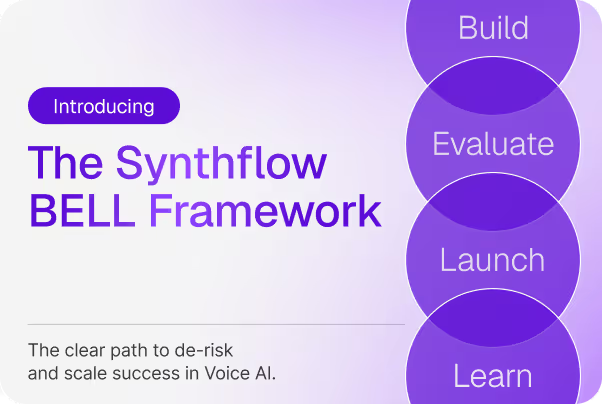Software
Decoding Vapi AI Pricing and Plans in 2025

Table of Contents

Vapi AI is a voice AI platform designed for developers to build and launch advanced voice agents. It works with tools like GPT-4, supports different voice providers, and lets you create custom call flows. While it's powerful, the pricing can be a bit confusing. Some important features cost extra or need to be set up manually, so the final price can be higher than it seems at first.
This article breaks down Vapi AI's pricing, what each plan includes, which features add extra costs, how setup works, and how it compares to all-in-one platforms like Synthflow.
How Vapi AI Pricing Works
Let’s start with the basics. Vapi AI gives you access to its platform through four main plans. These are priced monthly and include a fixed number of minutes for phone usage. Beyond those minutes, you’ll pay a per-minute overage fee.
Here’s the plan breakdown:
The Ad-Hoc plan is mostly for testing or very low call volumes. It’s a way to get started without committing to a full subscription. But if you’re running live calls every day, you’ll want one of the paid plans.
Agency and Startup are designed for teams handling a few thousand calls per month. Enterprise is flexible. It’s built around your usage, number of concurrent calls, call volumes, integrations, and support needs.
What’s Included in the Base Plans
Every Vapi plan includes access to the platform and some bundled minutes. That gives you a starting point, but most teams will need to add several features to make their agent work in a real-world setting.
Included:
- API access for managing agents, calls, and integrations
- Real-time voice agent infrastructure
- A web interface to test agents and see logs
- Limited SIP lines (depends on your plan)
- Basic hosting (Agency and Startup include $10 of credit)
Not included (and usually required for most production use):
- Voice output (TTS): You can bring your own or pay for built-in voice services
- Transcription (STT): Same deal — connect Deepgram or another provider
- AI language model (LLM): GPT, Gemini, or Claude — none are bundled
- Call recordings: 7-day storage is included in mid-tier plans, but unlimited costs $200 per month
- Compliance tools: HIPAA, PCI, and DPA are an extra $1,000 per month
- Support via Slack: That’s $2,000 per month if you want direct access to their team
SIP and Call Infrastructure
SIP (Session Initiation Protocol) lets your voice agents place and receive real phone calls. Each Vapi plan includes a certain number of concurrent SIP lines. That’s the number of calls your agents can handle at once.
Here’s what you get:
- Agency: 10 concurrent lines
- Startup: 50 concurrent lines
- Enterprise: 100 or more, depending on your setup
If you need more than that, you can add extra lines at $10 per line per month. These SIP lines are required to handle multiple simultaneous calls. Without them, your agent will queue or drop calls under load.
Hosting and Surge Costs
Vapi AI runs each call in its own container. This means you're charged for every minute the AI agent is active, even if the caller is on hold or silent.
- Standard hosting: $0.05 per minute
- Surge hosting: An extra $0.05 per minute during traffic spikes
This can add up, especially during busy hours or high call volume campaigns.
Real Cost Breakdown (Example)
Let’s say you’re running 10,000 minutes per month with a typical AI agent setup:
- Base plan: Startup ($800 for 7,500 minutes)
- Overage: 2,500 minutes × $0.16 = $400
- Hosting: 10,000 minutes × $0.05 = $500
- AI model usage: 10,000 minutes × $0.07 (GPT-4 API) = $700
- Voice output: 10,000 minutes × $0.05 = $500
- Transcription: 10,000 minutes × $0.01 = $100
Total: $3,000 per month, not including support, SIP upgrades, or compliance
Setup and Technical Needs
Vapi AI gives you building blocks. You get flexibility to design your system the way you want. But you have to do all the connecting. You’ll be managing API keys, setting usage thresholds, handling multiple vendor invoices, and keeping track of billing from at least four or five different providers.
You’ll also need to write or generate the actual prompt logic for your voice agent and build fallback paths for errors, misunderstandings, and transfers.
If your team is technical and likes to control every piece of the stack, this may feel like a good fit. If your team is focused on outcomes and wants to launch fast, this could be overwhelming and expensive to maintain.
Synthflow Comparison

You might be wondering, "Is Vapi AI expensive? How does it compare to other options?" To help you decide, here’s a side-by-side comparison of Vapi AI and Synthflow that looks at pricing and features so you can choose what works best for you.
Synthflow is a great alternative to Vapi and offers a single, transparent price that includes everything you need: voice, transcription, AI models, and more. There’s no need to bring in extra services or manage multiple tools. Setup is quick, billing is consistent, and there are no hidden charges. This makes it easy for teams to launch and run voice agents without delays or surprises.
Vapi AI, on the other hand, starts with a lower base rate but requires you to add and manage each service on your own. You’ll need to pay separately for voice, transcription, language models, and even hosting. This creates more work, more moving parts, and often a much higher total cost.
Synthflow makes it easier and faster to launch voice agents, with less work and more predictable costs.
Real-World Scenarios
1. Customer Support Line – 10,000 Minutes Per Month
A midsize business wants to run an automated customer support line that handles about 10,000 minutes of calls each month. These are mostly inbound calls answering common questions and booking appointments.
With Vapi AI:
- Plan: Startup at $800 per month (includes 7,500 minutes)
- Overage: 2,500 minutes × $0.16 = $400
- Hosting: 10,000 minutes × $0.05 = $500
- AI Voice (e.g., ElevenLabs): 10,000 minutes × $0.05 = $500
- Transcription (e.g., Deepgram): 10,000 minutes × $0.01 = $100
- Language Model (e.g., GPT-4): 10,000 minutes × ~$0.06 = $600
Estimated Total: $2,900/month
You need to manage four different services (hosting, voice, transcription, LLM), and pricing is not fixed, so monthly costs can shift.
With Synthflow:
- Plan: Agency at $1,250/month (includes 6,000 minutes)
- Overage: 4,000 minutes × $0.12 = $480
- All AI voice, transcription, and language model costs are already included in the minute rate
Estimated Total: $1,730/month
No third-party integrations or setup complexity. Everything is bundled in one place with clear pricing.
Result: Synthflow saves around $1,170 per month for the same call volume, with less maintenance.
2. Outbound Sales Follow-Ups – 5,000 Minutes Per Month
A sales team is running outbound follow-up campaigns for leads gathered from marketing funnels. Each agent call runs 1 to 3 minutes, and they do 5,000 minutes total per month.
With Vapi AI:
- Plan: Agency at $400/month (includes 3,000 minutes)
- Overage: 2,000 minutes × $0.18 = $360
- Hosting: 5,000 minutes × $0.05 = $250
- AI Voice: 5,000 minutes × $0.05 = $250
- Transcription: 5,000 minutes × $0.01 = $50
- Language Model: 5,000 minutes × ~$0.06 = $300
Estimated Total: $1,610/month
Again, the team has to manage five separate components, all with different pricing and billing cycles.
With Synthflow:
- Plan: Growth at $750/month (includes 4,000 minutes)
- Overage: 1,000 minutes × $0.12 = $120
- All required features are already included
Estimated Total: $870/month
Much easier to estimate. Everything is covered in the platform with no external contracts or keys to manage.
Result: Synthflow cuts costs by around $740 per month, while simplifying operations.
Final Thoughts
Vapi AI gives you tools. It gives you control. You can bring your own models, plug in your own speech engines, and customize your voice agents fully. That works best for technical teams that want to manage every detail. You can read our Vapi AI review on our blog and see how it performs.
Synthflow gives you the full system. Everything you need is built-in. You don’t need outside accounts or integration work. For many teams, this saves time and money and removes the need for engineering just to get started.
Both platforms are capable. The difference is how much of the setup you want to do yourself.



.avif)